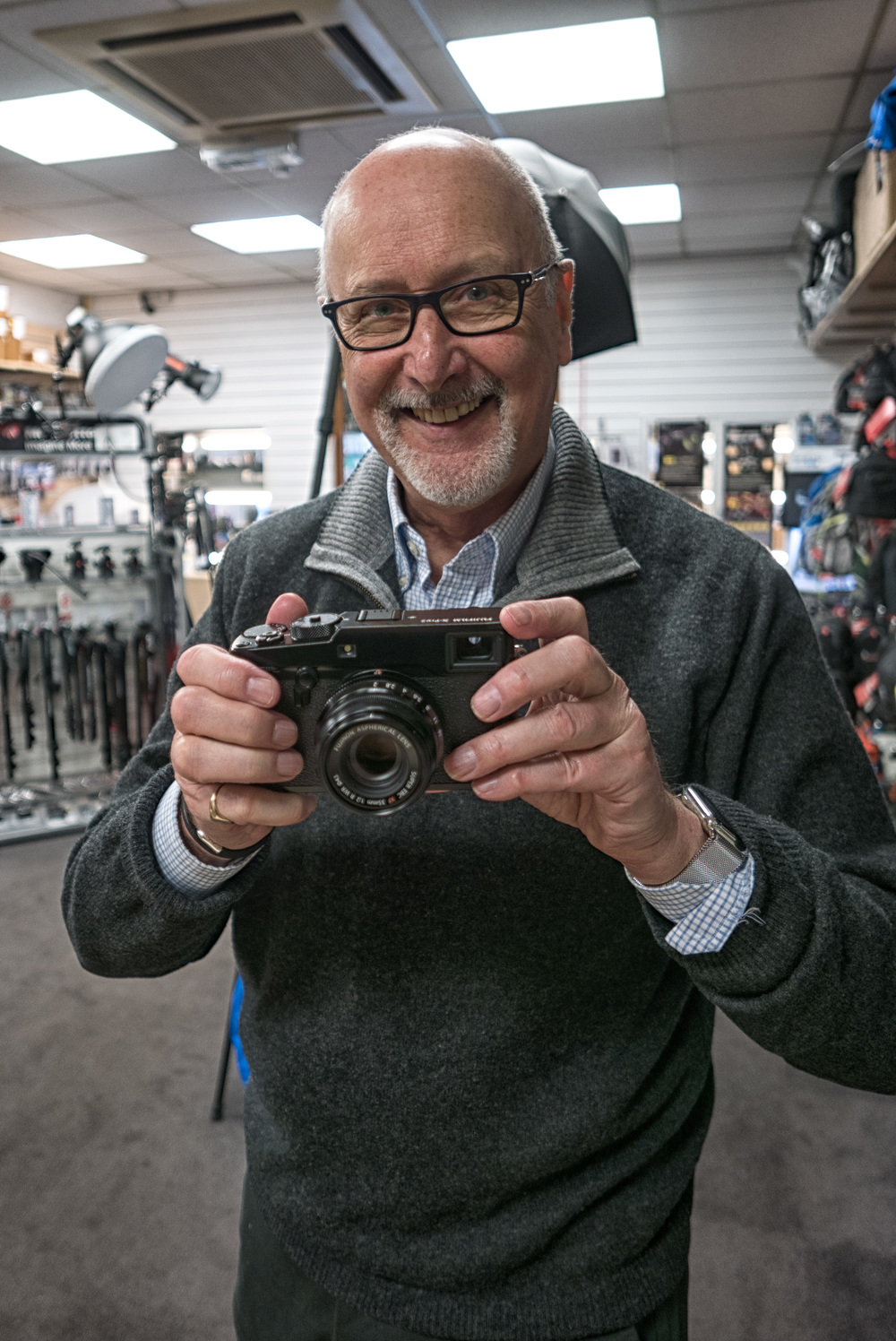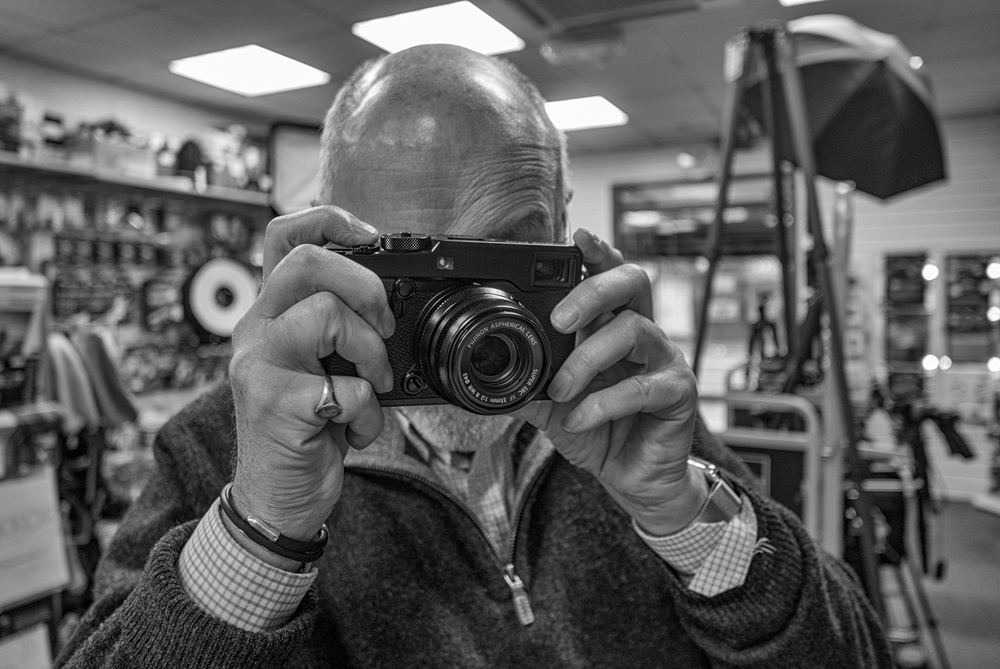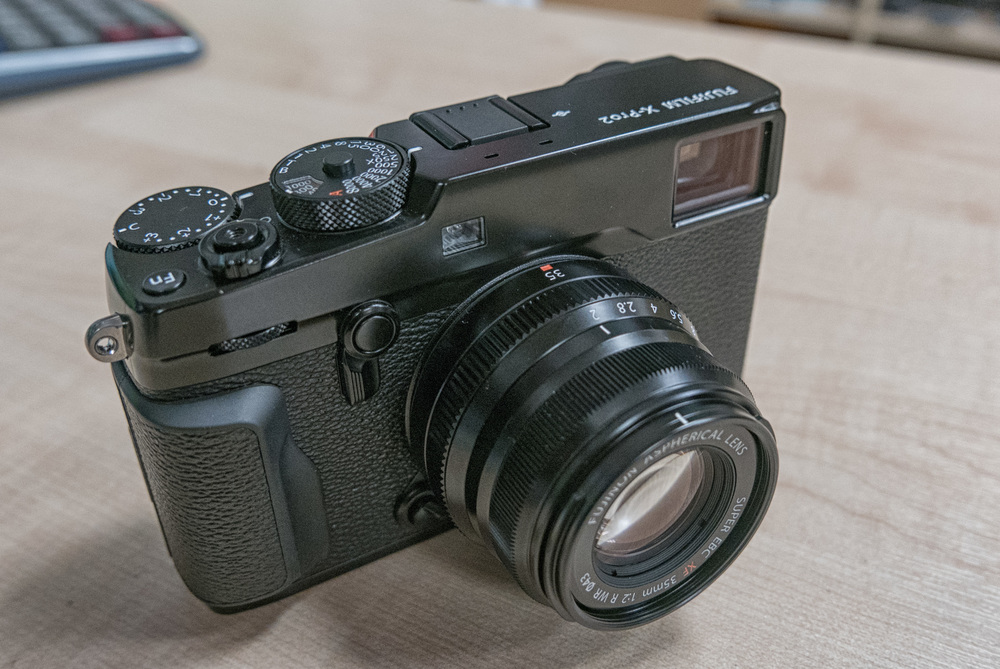This morning I was called to Chiswick Camera Centre to lay hands on one of the very few X-Pro2 cameras in captivity. The kindly Fuji representative had deposited the demo device for a day of fiddling. And fiddle I did.

I am impressed. It’s a long time (about four years) since I owned the X-Pro1 but my immediate verdict was that the new camera is better constructed than the old one, which in itself was no slouch in the quality stakes.
Control layout is ideal and, as usual with Fuji, there is a physical toggle to swap between screen, viewfinder and auto—something that is sadly missing on cameras such as the Sony A7 and the Leica Q. I also like the new ISO dial, nicely protected, in a window incorporated in the shutter speed dial.
With this camera you can see all your vital settings at a glance without needing to delve into menus. And, talking of protection, the new X-Pro is water and dust resistant. It will play nicely with the new generation of WR lenses (including the new f/2 35mm) that have been trickling through in the past couple of years.
The multitude of viewfinder modes, with optical (featuring information overlays) and electronic offerings, with additional tricks such as PIP focus, split-screen focus, work in much the same way as they do on the X100T. It can get confusing. But I do like the diopter adjustment on the viewfinder, a welcome addition that was lacking on the first generation X-Pro. As before, the split-screen focus is adequate but no real competitor for the Leica optical-mechanical system. With the X-T10 I soon found myself relying entirely on the electronic viewfinder.
From a styling point of view, the camera carries on from the X-Pro 1 and I really do appreciate the retro appearance. I prefer the rangefinder look to the DSLR styling of the X-T1. All in all, this is a very worthwhile upgrade that will grab the attention of mirrorless enthusiasts. For any seasoned X-Pro1 owner the upgrade is almost a foregone conclusion. They will want it.
The demonstration X-Pro was wearing the new 35mm f/2 lens and it is a real good looker with its slightly tapered and rather retro design. Superficially it looks very similar to a Leica Summicron-M. As a Leica lens owner, however, I find the transposition of focus and aperture rings unusual. With a Leica lens the aperture ring is at the front rather than behind the focus as with Fuji.
Although you can change the direction of the focus ring within the menu, there’s no such trick for the aperture dial which works opposite to Leica, with wider apertures to the right instead of the left. The focus ring on the Fuji also lacks the physical stops which Leica achieved on the electronic Q lens, for instance. There is an on-screen focus scale, which helps, but I do prefer a short physical throw from near to infinity with clear stops at either end. None of this, I suspect, will worry hardened Fuji hands but it is a slight disadvantage for anyone regularly using both Leica and Fuji.
As Bill Palmer found, however, this 35mm (50mm equivalent) new f/2 optic is a winner.



What camera did you use to grab these shots? The images are really good.
Eric, they were taken with my Leica D-Lux, a useful little camera to carry around.
Michael, I see you are left eye dominant, how doe the camera feel in this regard, does the vf stick out far enough to stop nose on screen issues. As an aside i use the 35mm f2 on my x-pro1 and x-t1 and it is sharper than a very sharp thing (as Blackadder would say) and also very fast and silent to AF even on the XP1. but that XP2 looks very nice but waiting for [rice to drop and also see what the x-t2 brings.
Very observant. I’ve written about eye dominance in the past and to me it is a bit like left and right handedness–something that comes naturally. I’ve had lots of sage advice about right-eye use leaving my face on full view (friendly like) with my left eye free to roam the scene. But I just can’t get the hang of it. Back to your question, the VF doesn’t stick out much, as I recall, but I didn’t notice any problems. In some ways, as a wearer of glasses, I think its better to be nearer the eyepiece rather than at a distance with large eyecups which, I am sure, are more comfortable for those who don’t wear glasses. Unfortunately nosey screens go with the affliction of left-eye dominance. The Leica Q has a very flat profile, which I can live with, while the Sony A7, X-T1 and (to some extent) the X-T10 all have large and more prominent rubber surrounds.
Bill Palmer has told me great things about the XF 35mm f/2 and if I give in and buy the X-Pro2 I will probably get one. Although the f/1.4 is a good lens, I’ve never particularly warmed to it because of its rather iffy construction and feeling of nothingness. It was also one of the debut XF lenses and things have moved on a long way since then.
Hi Michael,
As a glasses-wearer, how did you find the viewfinder?
Chris
I didn’t have long to play with the camera and only then inside the shop. But the viewfinder was good. I general I don’t have much trouble as a glasses wearer, even with the Leica rangefinder where I can usually cope well with 28mm lenses. One thing I did appreciate, though, was the diopter adjustment. It is quite firm so should hold its setting well and being able to adjust is a boon. The lack of a diopter on the X-Pro 1 was a major problem for me. I lost two £25 screw-in lenses in quick succession and that’s when I decided I couldn’t live with it.
I am not a great fan of the hybrid viewfinder since the optical view is a disappointment for anyone used to a rangefinder. Fuji present too many options and it encourages indecisiveness. That said, I suppose it’s good to have the options. The EVF is impressive, however, and a big improvement on the X-Pro 1.
Still cannot believe Fuji doesn’t have a 23/2 lens.